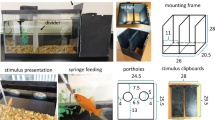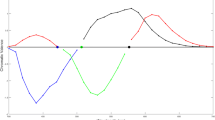Abstract
Visual acuity was measured in a two-choice training experiment with food reward. Four goldfish were trained to select a homogeneously illuminated testfield when a high-contrast grating (transparancy) was shown for comparison at the second testfield. Measurements were performed for white and monochromatic testfield illuminations in the light adapted state. Fourteen wavelengths between 404 nm and 683 nm were tested. For each wavelength (and white light) the testfield intensity was determined for which spatial resolution was highest. Between 446 nm and 683 nm maximal values of 2.0 cycles/deg (corresponding to a visual acuity of 15' of arc) were found. At 404 nm and in the ultraviolet resolution was lower (0.6 and ~0.25–0.35 cycles/deg, respectively). Cone and small ganglion cell densities may equally account for visual acuity. The action spectrum of maximal visual acuity is very similar to the spectral sensitivity function representing recognition of "colour". Measurements under reduced room illumination and after treatment with Ethambutol further indicate that the detection of high contrast gratings is processed by the same "channel" as colour vision. A similar separate and parallel processing of "colour" and "form" on the one hand, and "brightness" and "motion" on the other hand was found in humans.












Similar content being viewed by others
References
Aho A-C (1997) The visual acuity of the frog (Rana pipiens). J Comp Physiol A 180:19–24
Bilotta J, Powers MK (1991) Spatial contrast sensitivity of goldfish: mean luminance, temporal frequency and a new psychophysical technique. Vision Res 31:577–585
Bowmaker JK, Thorpe A, Douglas RH (1991) Ultraviolet-sensitive cones in the goldfish. Vision Res 31:349–352
Brunner G (1934) Über die Sehschärfe der Elritze (Phoxinus laevis) bei verschiedenen Helligkeiten. Z Vergl Physiol 21:296–316
Charman WN, Tucker J (1973) The optical system of the goldfish eye. Vision Res 13:1–8
Djamgoz MBA, Yamada M (1990) Electrophysiological characteristics of retinal neurones: synaptic interactions and functional outputs. In: Douglas RH, Djamgoz MBA (eds) The visual system of fish. Chapman and Hall, London, pp 159–210
Douglas RH, Hawryshyn CW (1990) Behavioural studies of fish vision: an analysis of visual capabilities. In: Douglas RH, Djamgoz MBA (eds) The visual system of fish. Chapman and Hall, London, pp 373–418
Fernald R (1990) The optical system of fishes. In: Douglas RH, Djamgoz MBA (eds) The visual system of fish. Chapman and Hall, London, pp 45–61
Hester F (1968) Visual contrast thresholds of the goldfish (Carassius auratus). Vision Res 8:1315–1335
Kirschfeld K (1976) The resolution of lens and compound eyes. In: Zettler F, Weiler R (eds) Neural principles in vision. Springer, Berlin Heidelberg New York, pp 354–370
Kock J-H (1982) Neuronal addition and retinal expansion during growth of the crucian carp eye. J Comp Neurol 209:264–274
Kock J-H, Reuter T (1978) Retinal ganglion cells in the crucian carp (Carassius carassius). I. Size and number of somata in eyes of different size. J Comp Neurol 179:535–548
Marc RE, Sperling HG (1976) The chromatic organization of the goldfish cone mosaic. Vision Res 16:1211–1224
Mora-Ferrer C, Neumeyer C (1996) Reduction of red-green discrimination by dopamine D1 receptor antagonists and retinal dopamine depletion. Vision Res 36:4035–4044
Mora-Ferrer C, Gangluff V (2000) D2-dopamine receptor blockade impairs motion detection in goldfish. Vis Neurosci 17:177–186
Mora-Ferrer C, Gangluff V (2002) D2-dopamine receptor blockade modulates temporal resolution in goldfish. Vis Neurosci 19:807–815
Neumeyer C (1984) On spectral sensitivity in goldfish: evidence for neural interactions between different "cone mechanisms". Vision Res 24:1123–1131
Neumeyer C (1986) Wavelength discrimination in goldfish. J Comp Physiol A 158:203–213
Neumeyer C, Arnold K (1989a) Tetrachromatic colour vision becomes trichromatic under white adaptation light of moderate intensity. Vision Res 29:1719–1727
Neumeyer C, Arnold K (1989b) Tetrachromatic colour vision in goldfish and turtle. In: Kulikowski JJ, Dickinson CM, Murray IJ (eds) Seeing contour and colour. Pergamon Press, Oxford, pp 617–631
Neumeyer C, Wietsma JJ, Spekreijse H (1991) Separate processing of "colour" and "brightness" in goldfish. Vision Res 31:537–549
Northmore DPM, Dvorak CA (1979) Contrast sensitivity and acuity of the goldfish. Vision Res 19:255–261
Palacios AG, Varela FJ, Srivastava R, Goldsmith TH (1998) Spectral sensitivity of cones in the goldfish, Carassius auratus. Vision Res 38:2135–2146
Penzlin H, Stubbe M (1977) Untersuchungen zur Sehschärfe des Goldfisches (Carassius auratus L.). Zool Jahrb Abt Allg Zool Physiol 81:310–326
Schaerer S, Neumeyer C (1996) Motion detection in goldfish investigated with the optomotor response is "color blind". Vision Res 36:4025–4034
Snyder AW, Miller WH (1977) Photoreceptor diameter and spacing for highest resolving power. J Opt Soc Am 67:696–698
Spekreijse H, Wietsma JJ, Neumeyer C (1991) Induced colour blindness in goldfish: a behavioral and electrophysiological study. Vision Res 31:551–562
Sperling HG, Harwerth RS (1971) Red-green cone interactions in the increment-threshold spectral sensitivity in primates. Science 172:180–184
Stell WK, Hárosi FI (1976) Cone structure and visual pigment content in the retina of the goldfish. Vision Res 16:647–657
Wässle H (1986) Sampling of visual space by retinal ganglion cells. In: Pettigrew JD, Sanderson KJ, Levick WR (eds) Visual neuroscience. Cambridge University Press, Cambridge, pp 19–32
Zeki S (1993) A vision of the brain. Blackwell, Oxford
Zrenner E, Krüger CJ (1981) Ethambutol mainly affects the function of red-green opponent neurons. Doc Ophthalmol Proc Ser 27:13–25
Acknowledgements
For technical assistance I would like to thank M. Grosz, J. Altmayer, W. Hoch, H. Huber, and the workshop of the Institute. Mark von Campenhausen improved the setup at a very early stage of the study; Ludmila Belovsky and Carlos Mora-Ferrer performed part of the training experiments. For helpful discussions I am very grateful to Tom Reuter and Christoph von Campenhausen.
Author information
Authors and Affiliations
Corresponding author
Rights and permissions
About this article
Cite this article
Neumeyer, C. Wavelength dependence of visual acuity in goldfish. J Comp Physiol A 189, 811–821 (2003). https://doi.org/10.1007/s00359-003-0457-4
Received:
Revised:
Accepted:
Published:
Issue Date:
DOI: https://doi.org/10.1007/s00359-003-0457-4




